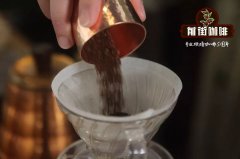The finer the coffee beans are ground, the easier the antioxidants will dissolve! How can coffee beans taste good?

Professional coffee knowledge exchange more coffee bean information please follow the coffee workshop (Wechat official account cafe_style)
Coffee is the most complex food in the known natural substances. Scientists have isolated more than 300 chemicals from raw coffee beans and more than 800 kinds of cooked beans, including many acidic organic compounds, which are not only the source of the sour flavor of caffeine. It is also a healthy antioxidant.
Info_img
Among them, chlorogenic acid (chlorogenic acids) is the most abundant. Han Huaizong points out that chlorogenic acid is unflattering in taste buds and bitter in the mouth, but it has a strong ability of anti-oxidation and scavenging free radicals. Studies have found that chlorogenic acid can help the human body fight cancer. After baking, chlorogenic acid is decomposed into quinic acid (quinic acid) and caffeic acid, which also has antioxidant effect.
Coffee addicts agree that the most fragrant moment of ─ coffee is not when you drink it, but when you grind the beans and just cook them. The fragrance in the room makes people feel happy. This is the role of volatile antioxidants. The finer the ground beans and the more particles, the larger the total area of contact with the air, and the antioxidants will easily evaporate.
So, in order to reduce volatilization, can the intake of antioxidants be increased by grinding coffee beans to coarse particles? Han Huaizong, author of Coffee Science, disagrees. He believes that if these volatile antioxidants cannot be dissolved in water, they cannot be eaten even if they are left with more.
"only water-soluble antioxidants can be absorbed by the human body, and the finer the grinding, the higher the extraction rate, and the easier it is to dissolve organic acids and phenolic antioxidants," he suggests.
Different coffee machines should use different grinding degrees.
Although theoretically, the finer the coffee beans are ground, the easier the antioxidants will dissolve, but in practice, it is still necessary to consider the way of brewing coffee and the length of brewing time to adjust a more suitable degree of grinding.
If the grinding is too fine, the water and the coffee powder surface contact too much, easy to extract too many impurities and bitter taste, but if the grinding is too rough, gouache contact is not enough, you will not be able to brew the aroma of coffee.
Therefore, generally speaking, the powder particles from fine to coarse, corresponding to the appropriate coffee machine can be divided into several types:
● espresso grinding (espresso grind): very fine particles, suitable for espresso machine.
● fine grinding (fine drind): suitable for mocha pot and hand dripping filter cup.
● grinding (medium grind): suitable for manual drip filter cup, American coffee pot, siphon pot.
● rough grinding (coarse grind): suitable for French filter kettle.
As for when to grind coffee to preserve the most complete nutrients? Chang Wen-Wei, director of the Taipei boutique Coffee Association and head of the Coffee consciousness Cafe, points out that if time permits, "grinding and cooking now" is the best, because once coffee beans are ground, the rate of oxidation and deterioration of coffee beans is accelerated, not only the antioxidants are decreasing, but also the flavor is getting worse.
Important Notice :
前街咖啡 FrontStreet Coffee has moved to new addredd:
FrontStreet Coffee Address: 315,Donghua East Road,GuangZhou
Tel:020 38364473
- Prev

Coffee beans get better as they age? The doctor taught you how to eat coffee beans is the healthiest.
Professional coffee knowledge exchange more information about coffee beans Please follow the online rumors in the coffee workshop (Wechat official account cafe_style) that coffee beans are like old wine, the older the better, which has been severely slapped in the face by coffee roasters and doctors. Chen Zhihuang, winner of the 2013 Nordic Cup Coffee Baking Competition and with nearly 20 years of experience in roasting coffee beans, said that coffee beans are like fresh food.
- Next

Introduction to the types and tastes of coffee beans the price of coffee beans does not represent quality
Professional coffee knowledge exchange more coffee bean information please follow the coffee workshop (Wechat official account cafe_style) coffee beans: there are more than 100 kinds of coffee in the world, but at present there are two most common coffee beans: Arabica and Robusta these two kinds of coffee are different in flavor, caffeine proportion and planting conditions.
Related
- Beginners will see the "Coffee pull flower" guide!
- What is the difference between ice blog purified milk and ordinary milk coffee?
- Why is the Philippines the largest producer of crops in Liberia?
- For coffee extraction, should the fine powder be retained?
- How does extracted espresso fill pressed powder? How much strength does it take to press the powder?
- How to make jasmine cold extract coffee? Is the jasmine + latte good?
- Will this little toy really make the coffee taste better? How does Lily Drip affect coffee extraction?
- Will the action of slapping the filter cup also affect coffee extraction?
- What's the difference between powder-to-water ratio and powder-to-liquid ratio?
- What is the Ethiopian local species? What does it have to do with Heirloom native species?

